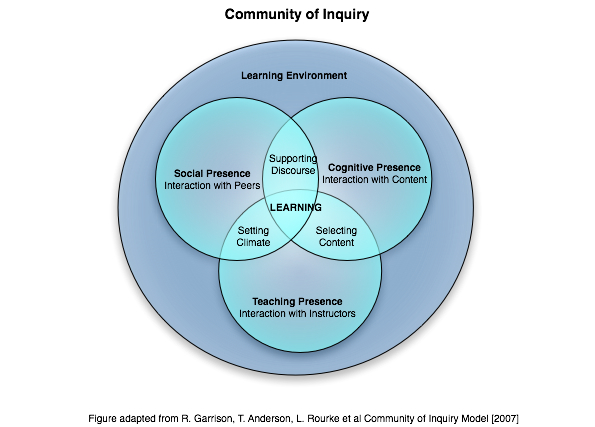Documentation:Creating the Online Learning Environment/Teaching in an Online Context
Teaching in an Online Context
As Terry Anderson points out, “learning and teaching in an online environment are, in many ways, much like teaching and learning in any other formal educational context” (2004). The difference, he argues, is that the online environment creates a unique environment for teaching and learning: one that is flexible (time and place can vary), multimedia rich, and communications rich. Taking that notion a step further, Cormier and Siemens (2010) among others, propose the notion that as educators experiment with social media and interactive pedagogies, the whole notion of a course as THE vehicle for learning is challenged. Educators are grappling with questions around effectiveness and engagement. Where does the learning happen? By reading texts or viewing lectures online? Through discussions with peers and facilitators? In self organized "study groups" or chat sessions? What types of learning environments best support a full range of these activities? At the very heart of the matter is the broadly accepted view that people learn best in the context of networks or communities of people.
A very useful schema for thinking about the creation of an effective online educational community was developed by Garrison, Anderson and Archer (2000) based on extensive qualitative and quantitative research work undertaken at the University of Alberta (for more papers resulting from their research, see http://www.atl.ualberta.ca/cmc). This conceptual model is called the “community of inquiry” model:

This model postulates that deep and meaningful learning results when there are sufficient levels of three inter-related “presences” in a virtual learning environment:
- Social presence: this relates to the creation of a supportive environment in which learners feel able to express their ideas and collaborate on construction of new knowledge. In the absence of social presence, learners feel unable to disagree, share viewpoints, explore differences or accept support and confirmation from peers or facilitators.
- Cognitive presence: this is the creation of an environment that promotes critical thinking in relation to the content area at hand.
- Teaching presence: describes the creation of an instructional relationship appropriate to the learning community and the topic at hand. It is defined as the “design, facilitation, and direction of cognitive and social processes for the purpose of realizing personally meaningful and educational worthwhile learning outcomes” (http://communitiesofinquiry.com)
Look closely at the model again. Note how the instructor/facilitator plays a key role in both ‘setting the climate’ and ‘selecting the content’ of an educational experience. Open educators would call this content selection "curating" since much of the content may be freely available on the internet. It has become quite clear that early fantasies of computers ‘replacing’ educators are, simply, fantasy.
It's worth noting that in different contexts, the ‘educators’ involved in online learning have different names. In the UK, and parts of the world with historic and linguistic ties to British English and British education, it is common for online educators to be referred to as ‘tutors’ – a term which in British English is relatively benign. In North America (and parts of the world who are heavily influenced by North American language and educational systems), online educators are more commonly referred to as ‘instructors’, especially in the higher education context, although as you will see, theory and training places heavy emphasis on the ‘facilitator’ role that instructors play.
In adult and continuing education, both face-to-face and online, it is common for educators to be called 'facilitators', to highlight their primary role as a helper or enabler who assists a group to achieve their best thinking, rather than as ‘content experts’.
In courses offered by the UBC Centre for Intercultural Communication, the educators who work directly with learners are also called ‘facilitators’, although most also have content expertise that they contribute where appropriate. Each course is also ‘managed’ by a moderator, who makes sure that course logistics proceed smoothly, and who liaises with facilitators and students to keep things on track.
You will notice different terminology in the various resources linked to these course materials, but the principles and practices they suggest are nevertheless relevant for facilitators working online in a variety of contexts.
Exploring the Model
Pause here to read both the Garrison et al (2000) paper, especially the sections outlining the three ‘presences’ as well as the Cormier/Siemens article.
- Cormier, A., Siemens, G. (2010). Through the Open Door: Open Courses as Research, Learning and Engagement.EDUCAUSE Review, vol. 45, no. 4 (July/August 2010): 30-39
- *Garrison, D. R., Anderson, T. & Archer, W. (2000). Critical Inquiry in a Text-based Environment: Computer Conferencing in Higher Education. The Internet and Higher Education, 2(2), 87-105.
You might also like to explore the Community of Inquiry website that summarizes these ideas and links each summary to the authors’ more detailed papers on the topic.